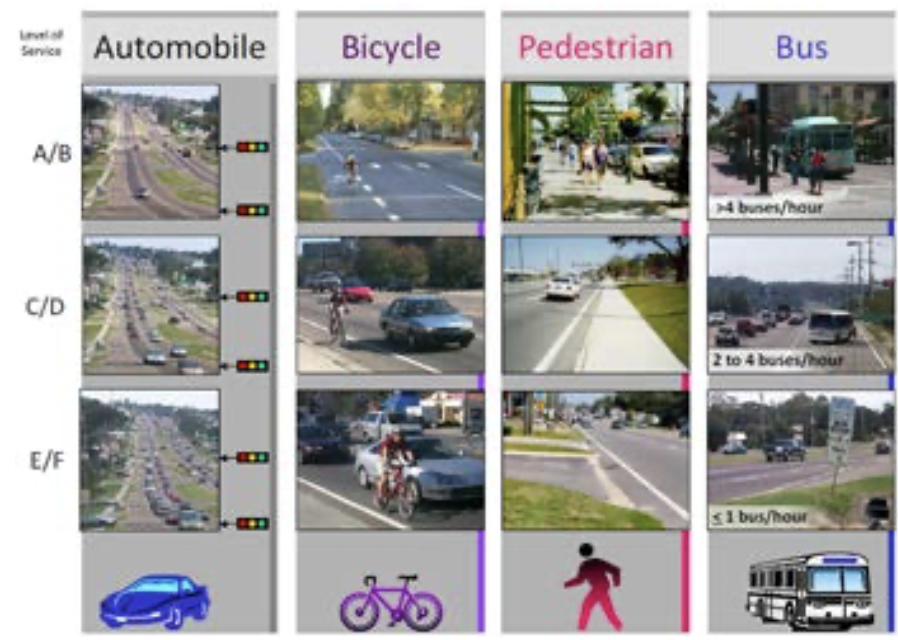2.4: Asset Condition, Level of Service and Performance
- Page ID
- 21114
Asset management systems can focus upon improving condition, performance (often called level of service) or some combination of these characteristics. For infrastructure asset management, condition relates to the functionality of a particular infrastructure component and its deterioration process. Performance and level of service refer to the user experience and use of the infrastructure itself. Performance and level of service can also be defined and measured for processes that are not infrastructure, such as patient waiting time on visiting a hospital emergency room. Facilities management processes can also have process performance measures, such as response time and communications adequacy to repair requests.
Figure 2.6 illustrates levels of service for four different transportation modes as originally defined by the Florida Department of Transportation. The automobile level of service is usually defined by the volume of traffic relative to the roadway capacity. As volume increases, congestion and delay also increase with a progression from the level of service A (free-flow traffic) to F (traffic jam). For bicycles, the level of service is defined by the separation from the dangerous vehicular traffic stream. For pedestrians, sidewalk amenities, provision of sidewalks and separation from vehicular traffic influence level of service. For buses, the level of service is defined with respect to the frequency of service and crowding on the buses.

Figure 2.6 - Pictorial Examples of Level of Service A to F for Multiple Transportation Modes.
Source: FHWA, Public Domain, https://ops.fhwa.dot.gov/publication...035/chap10.htm
Individual components of infrastructure systems can also have level of service and performance measures. Figure 2.7 shows the levels of service for intersections with traffic signals defined by the California Department of Transportation. In this case, the level of service and performance is related to the average delay per vehicle at the intersection. Note that the factors affecting level of service relate to the intersection infrastructure (such as traffic signal and geometric conditions) as well as the traffic volumes (such as numbers of pedestrians and trucks).
 Figure 2.7 - Example of Level of Service for Signalized Intersections.
Figure 2.7 - Example of Level of Service for Signalized Intersections. Source: California Department of Transportation, http://www.dot.ca.gov/ser/forms.htm Redrawn and altered by Authors.
Infrastructure performance can be a multi-dimensional consideration. For example, telephone service performance includes aspects of coverage (for cellular phones), dropped calls (again for cellular phones), sound quality and user costs.
For nearly all infrastructure systems, performance and level of service depend upon the infrastructure condition. For example, unreliable cellular telephone routers will degrade service performance. Leaky roofs are both a condition and a user problem. Rough and potholed roadway surfaces reduce the speed of traffic flow even at low traffic volumes. Moreover, the infrastructure conditions can be influenced directly by maintenance or rehabilitation activities initiated by an infrastructure manager, so the condition of infrastructure is often emphasized in infrastructure asset management.
The measures of infrastructure performance differ from system to system. Some typical performance measures would include:
-
Asset condition assessed in processes of inspection and modeling of deterioration. Index scales are often used to summarize conditions as described in later chapters.
-
Asset value is closely tied to condition as well as use.
-
Cost for both owners and users of the infrastructure. Owner costs include
maintenance, operations, and rehabilitation. User costs include waiting or delay
times.
-
Customer service related to communications and response to requests.
-
Safety measured by the numbers and extent of injuries or risks.
-
Reliability measured by the availability of infrastructure services both in normal
service and in extreme events such as hurricanes.
-
Sustainability related to the overall economic impact of the infrastructure,
environmental emissions and resource consumption, and social impacts.
Fortunately, infrastructure managers can generally use organizational or well- established metrics of performance for asset management. Obtaining user costs can be more difficult, and may require special data collection efforts or surveys. For example, traveler delays on roadways may be assessed by measuring the speed of vehicles traveling over the network.
In later chapters, we will discuss the individual processes and approaches to condition assessment and infrastructure performance.


